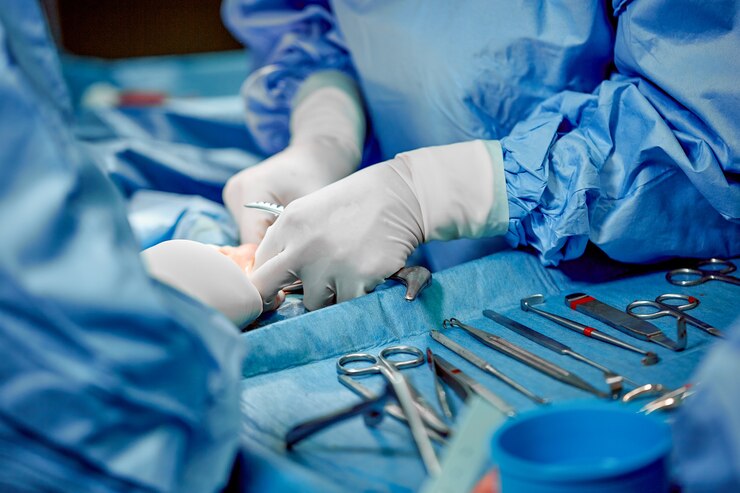Medical professionals have to come across several ear, nose, and throat (ENT) surgical procedures. So, they require a number of instruments for these surgeries. ENT procedures include the diagnosis and treatment of head and neck disorders.
Ear instruments are not only intended for carrying out the procedures that address ear problems but are also effective for nose and throat surgeries. There are several kinds of ear disorders that need surgeries. Therefore, many instruments are available to handle the complications.
The common ear disarrangements include balance disorders, cholesteatoma, acute mastoiditis, vestibular neuronitis, ear Infections, otitis externa, otitis media, ear ringing (tinnitus), perforated eardrum, and hearing loss.
There are four common surgeries in which ear instruments are frequently used. They include myringoplasty, ossiculoplasty, tympanoplasty, and mFastoidectomy. For example, in Myringoplasty, ENT specialists treat the eardrum holes using knives, forceps, hooks, retractors and speculums, scissors and nippers, and suction tubes.
Similarly, mastoidectomy requires mastoid curette, micro ear suction, graft press Lempert elevator, Hartmann forceps, Micro Ear Cupped Forcep, Bayonet Forceps, Chisels, and Gouges. Other ear surgeries also require various ear instruments.
Commonly Used Ear Instruments
ENT specialists need a number of ENT surgical instruments for ear operations. All instruments are available in multiple variations to help surgeons handle fluctuating situations. Let’s discuss some common ear instrument names and applications.

Disposable Ear Curette
Surgeons use disposable ear curette for cleaning the ear canal. It features a long handle and a ring-like round tip making it an atraumatic tool. The instrument is effective for only one-time use. It helps carry out a contamination-free procedure. Moreover, the variations of the instruments come with cupped end and loop end.
Lempert Curettes Oval Cup
Lempert Curettes Oval Cup helps ENT specialists make incisions of the middle ear and eustachian tube. The instrument has an overall length of 8’’. The non-slippery handle grip makes it a more efficient tool. Moreover, it is german forged and available in multiple variations.
Buck Ear Curette Angled Sharp
Buck Ear Curette Angled Sharp features a blunt-ended loop. Surgeons use it to clean the ear canal. It helps remove the excess cerumen in an atraumatic way. Moreover, it has an overall size of 5 3/2” with multiple tip sizes.
Wilde Ear Forceps
Wilde ear forceps is one of the most significant ear instruments. It aids in grabbing tissues and packing for the nose. It has jaws with serrations and an 80° angle at both ends. Moreover, German forging gives the tool greater toughness and a longer lifespan. Also, it requires little upkeep. There is a 1×2 tooth version available for these forceps instruments.
Wullstein Ear Forceps
These versatile ear forceps are helpful in several ENT procedures. Medical professionals use these forceps to extract polypus and grasp foreign material. Additionally, they are available in an overall length of 3” with an oval cup and round cup shaft. German forging makes the instrument more efficient and durable.
Alligator Ear Forceps
Alligator Ear Forceps feature a delicate design and are the perfect instrument for ear treatment. Surgeons use these forceps tools for the pathologies of the ear. The fenestrated and oval jaws of the tool make it more efficient for polypus removal. Moreover, the forceps are perfect for enhancing the visibility of the surgery site for the surgeons.
Alligator ear forceps are available in overall sizes of 2 ½” and 5 ½” with a narrow shaft, toothed jaws, and round cup jaws.
Hartman Ear Forceps
Hartman ear forceps help ENT specialists remove hair from the ear. Thus, they are useful for reducing the chances of natural tremors. The other names for these forceps are crocodile forceps or alligator mouth forceps. Surgeons also call them Hartman foreign body forceps.
Moreover, they are German forged and are the perfect option for narrow places. They are available in serrated and regular pattern jaws.
Day Ear Hook
Day Ear Hook is an ENT instrument that helps clean the ear canal before starting a procedure. It is german forged, making it reusable and rust-free. Moreover, the hook is available in small and large sizes.
Farrell Applicator
Farrell applicator is a helpful instrument in middle ear procedures. Surgeons use it to remove pus and apply cotton after surgery. The longer shaft allows for the most ear canal access possible. Additionally, it comes in a 6 12″ overall size with a cross-serrated tip and a triangular tip.
Toynbee Ear Specula
Toynbee ear specula are used to straighten the ear canal. The oval-shaped funnel design of the tool helps increase the visual axis. In addition, it is German forged, that’s why it’s lightweight and reusable.
Baron Suction Tube
Baron Suction Tube is a versatile ENT tool. It is helpful to clean external auditory meatus. Additionally, it assists surgeons in the easy and quick removal of cerumen.
Buy Durable and Ergonomic Design Ear Instruments
From the above discussion, we can get the critical uses of ear instruments. Besides ear procedures, these tools are effective for neurosurgeries. Therefore, surgeons should choose the finest quality ENT equipment. The accuracy and precision should be the priority of the professional while buying any instrument.
If you are an ENT specialist and need the finest craft ENT surgical instruments, GerMedUSA.com is the best choice. They have German forged performance-tested instruments. All instruments are available in a number of variations for surgeons’ convenience. Moreover, if you don’t find an instrument you need, they can manufacture it for you on first priority.
FAQs
-
What do ENT surgical tools do?
Head and neck instruments is another name for ENT surgical tools. The ear, nose, and throat procedures require these instruments. In addition, ENT treatments also include neurosurgical operations.
-
What are suction tubes used for during ear procedures?
To make the operation site clean and smooth, suction tubes help remove cerumen and other fluid debris from inside the ear. Thus, they make the procedure less hectic and prevent complications.
-
What is the purpose of disposable ear curettes in surgery?
In order to clean the ear canal without spreading any germs, disposable ear curettes are preferable. Reusable tools may have the potential of transmitting germs, however, German-forged instruments can be autoclaved and are reusable.






